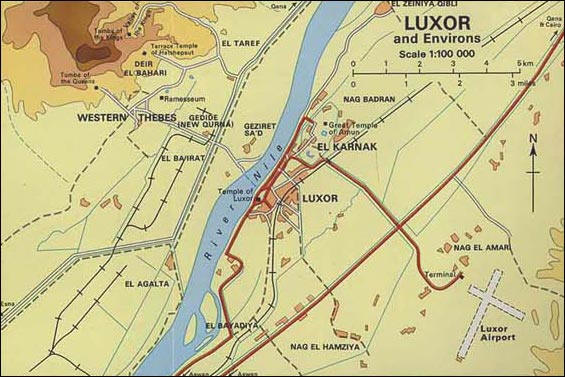
Known to the ancients as "Thebes," Homer described the place as "City of The Hundred Gates." The East bank of the Nile, home of the living, hosts the famous temple Karnak. The West bank, land of the dead, hosts the Necropolis of Thebes, including the famous Valley of the Kings. We started our tour at Deir el Medina in the Workers Village in the West Bank. The atlases at The Theban Mapping Project to get a good view of the landscape and the location of the Workers Village, among other locations. The ancient village workers were the artisans who engineered and decorated the West Bank necropolis during a 500 year span starting around 1500BC. The necropolis includes numerous burial locations besides the Valley of the Kings. For example, nobles were buried in Deir el Medina near the workers village. Many of the nobles' tombs are the best preserved on the entire West Bank. We visited the tomb of Sennedjem. It was small, but beautifully decorated. Photos weren't allowed, so a post card is copied below.
The Valley of the Kings represents one of the most sacred places in all of historical Egypt. Unfortunately, the Valley was a tourist mob scene that would rival Disney World. With over 60 tombs, only a few are setup for safe public viewing. Many are the subject of on-going excavation and research, off limits to all but those "in the know." Tomb #62, the highest number, is that of King Tut. In the picture below, notice the "horn" mountain overlooking the valley. It certainly looks like a pyramid!
Ironic that there's so much to explore in the Valley of the Kings, and yet, there's such a crowd to avoid! Queen Hatshepsut's mortuary temple, not far from the Valley, seems so much more spacious. This grand temple was know to the Queen as her "Splendor of Splendors." Queen Hatshepsut (pronounced by quickly slurring "Hot Chicken Soup") was Egypt's only woman Pharaoh. The pharaonic blood line was carried by women. Hatshepsut married Pharaoh Thuthmoses II who died shortly thereafter. Her confidant and lover, Senmut, built the temple in honor of Amon and Hathor, Hatshepsup's claimed parents. Succeeding Pharaohs tried to erase evidence of Hatshepsut's rule. The temple was buried and largely forgotten until recent times. With such a grand presence, the temple certainly has a woman's touch!
After seeing a few more sights on the West Bank, we crossed the Nile for a tour of the Karnak Temple complex. Karnak houses dozens of smaller temples inside of three main "precincts" on 247 acres. It's the largest man-made religious shrine in the world, and a big-time party place. After the 18th Dynasty, Karnak was a place to celebrate the festival of Opet for 27 days during the inundation of the Nile. The festival included a dramatic precession of Amun. Amun's idol was ceremonially carried on an arc through town from the Temple of Amun to the Luxor Temple, approximately 1.5 miles.
Amun was often associated with the ram. In the image below on the right, is the entry to Karnak, surrounded by ram sculptures, each holding a tiny effigy of the Pharaoh. Actually, the image is a copy of an entry ticket for the "Sound and Light Show." It's a night-time tour of the temple followed by a sit-down show overlooking the temple's "sacred pond." We had seen so much, and gone so far on that day, that it was difficult to stay awake during the entire show.
Among the most fascinating things about Karnak are the obelisks and towering columns of the "hypostyle" hall. The hall is considered to be one of the world's greatest architectural masterpieces. Construction began during Ramesses I's reign. He was the king who founded the Nineteenth Dynasty and was king for only one year. The work continued under Seti I (1306 - 1290 BC). The hall was completed by Seti I's son, Ramesses II. The hall ceiling was 82 feet high and was supported by12 sandstone columns shaped like papyrus in two rows of six. Each row of columns is flanked on either side by 7 rows of columns that are 42 feet high. Each of these rows has 9 columns, although inner rows only have 7 columns. The images within the hall symbolize the story of creation. Some of the original painting is still visible. It's an awe inspiring feat of architecture and art!
Of course, there plenty of other things we saw, like the massive statue of Ramesses. After a long day with the antiquities, we were dead tired, and ready for a nap. Below is a picture of my shoes just before bed, covered in the "dust of the Pharaohs"